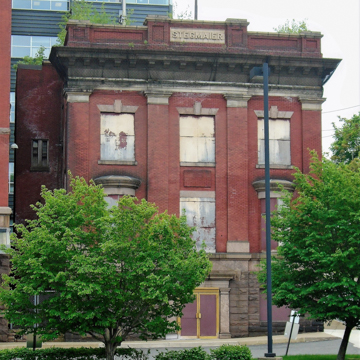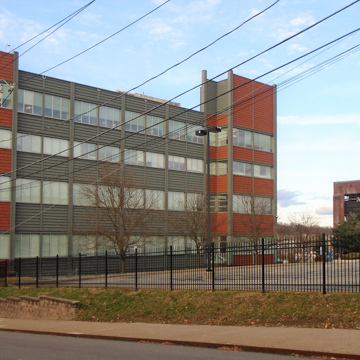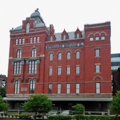You are here
Stegmaier Federal Office Building (Stegmaier Brewing Company)
The eastern entrance to downtown is dominated by the brooding dark surfaces and stumpy towers of this vast edifice, reminders of Wilkes-Barre's German heritage and industrial legacy. Founded in 1857, the Stegmaier Brewing Company was the largest brewing company in Pennsylvania outside of Philadelphia and Pittsburgh in the early twentieth century. Philadelphia-based brewery specialist Wagner topped the six-story Bavarian brew house with a cupola and elaborately decorated with terra-cotta bacchi and assorted lager-drinking cherubs. Regulations required that the brew house and bottling house be in separate buildings for ease of taxing the quantity of production; here they are picturesquely grouped to either side of E. Market Street. The complex includes a cold storage building and bottling house, designed by Wilkes-Barre architects McCormick and French, and a Classical Revival brick office building by Charles H. Caspar, another Philadelphia brewery specialist. All are conspicuous in their heavy use of Wyoming bluestone, provided by the Brownscombe quarries at Meshoppen, upriver on the Susquehanna. Abandoned after merger with a crosstown rival, the brew house was restored after a long preservation battle, and now serves as a federal office building, open to visitors during regular business hours.
Writing Credits
If SAH Archipedia has been useful to you, please consider supporting it.
SAH Archipedia tells the story of the United States through its buildings, landscapes, and cities. This freely available resource empowers the public with authoritative knowledge that deepens their understanding and appreciation of the built environment. But the Society of Architectural Historians, which created SAH Archipedia with University of Virginia Press, needs your support to maintain the high-caliber research, writing, photography, cartography, editing, design, and programming that make SAH Archipedia a trusted online resource available to all who value the history of place, heritage tourism, and learning.






















